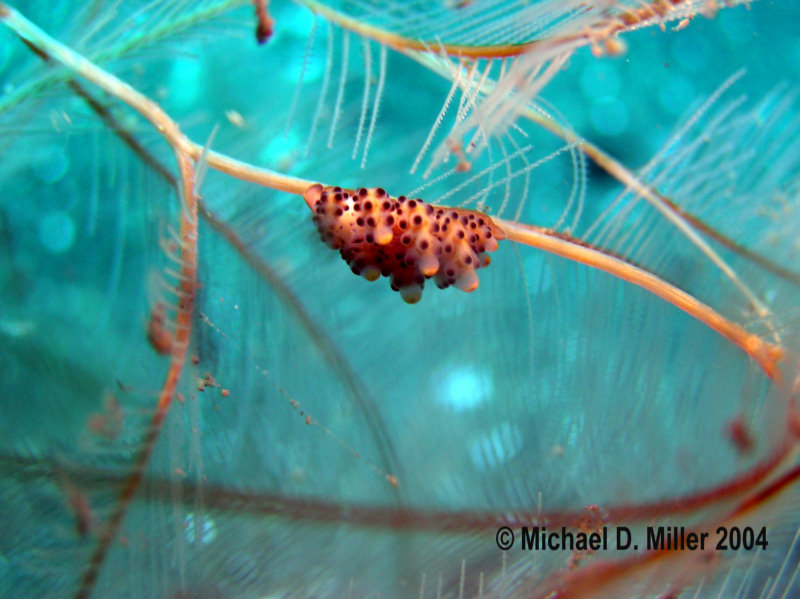 |
Doto bella
Photo courtesy of WebmasterPhoto taken at Puri Jati, Bali, Indonesia
Oct. 2003
Doto bella Baba, 1938
Members of the dendronotacean genus Doto are small interesting critters well represented in both temperate and tropical seas. They are characterized by their smooth rhinophores situated in a cup-shaped sheath and their knob covered cerata. All species are small, usually less that 10-15 mm in length and feed on hydroids.
At first glance I thought Mike's photo shown here was an ovulid snail, hiding under it's cryptic mantle ornamentation, but no, the lumpy appendages are the cerata of Doto bella as species described by Kikutaro Baba in one of his early monographs.
D. bella has only been reported from Japan and Indonesia. In the original description, Baba says there is a black patch midway on each rhinophore. We can't see the rhinophores in Mike's photo, but the cerata certainly match the description. See the photo on page 129 in Tonozuka's Opisthobranchs of Bali and Indonesia of a nearly identical specimen.
There are photos labeled Doto bella on page 99 of Coleman's 1001 Nudibranchs from New Zealand, but Rudman notes in his Doto from New Zealand message, it is likely not D. bella and is probably undescribed. Susuki, page 126 of Opishtobranchs of Izu Peninsula also has a photo identified as D. bella , but again the specimen shown does not match Baba's description of the rhinophores.
Note in Mike's photo you can clearly see the campanularid hydroid that this species preys on.
References:
Baba, K. (1938) Opisthobranchia of Kii, Middle Japan. Journal of the Dept of Agriculture, Kyushu Imperial University, 6(1): 1-19.
Coleman, N. 2001. 1001 Nudibranchs - Catalogue of Indo-Pacific Sea Slugs, Neville Coleman's Underwater Geographic Pty Ltd. 144pp.
Susuki, K. 2000. Opisthobranchs of Izu Peninsula. Hankyu Communications, Japan. 178 pp.
Tonozuka, T. 2003. Opisthobranchs of Bali and Indonesia. Hankyu Communications, Japan. 165 pp.
Danville, Calif
Feb. 2004
WEBMASTER'S NOTES: This photo was taken with a housed Olympus 750 UZ in program mode with a 5400 K video light. Although the photo itself is nothing to write home about, it does illustrate the ability of the 750 UZ to function in area of extreme or super macro. Animal was in the range of 5 to10 mm. The video light had to be used as the Olympus 750 cannot function with a slave strobe in the super macro mode. If anybody from Olympus is reading this, this ability would be a welcome addition in the next version.
Taxonomic information courtesy of:

David W. Behrens
Author:
Pacific Coast Nudibranchs
Send Dave mail at dave@seachallengers.com
|
